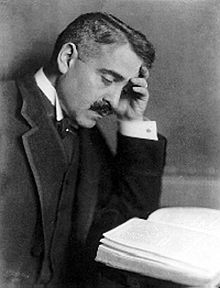Science award from the Aby Warburg Foundation
The Science Prize of the Aby-Warburg Foundation (formerly the Aby-Warburg Foundation Prize and the Hans Reimer Prize of the Aby Warburg Foundation ) has been a science prize that has been awarded since 1995 and is primarily aimed at art historians and scholars who have made special contributions to the cultural sciences and humanities have been awarded. The prize is endowed with 5,000 euros and is associated with a lecture. The award is named after the art historian Aby Warburg .
The award ceremony takes place in the library of the Warburg House in Hamburg.
Award winners
| year | Award winners | Title of the talk |
|---|---|---|
| 1995 | Barbara Stafford | Violence In Natural History: On The Durability Of A Graphic Dilemma |
| Herfried Münkler | National Myths in Early Modern Europe | |
| 1996 | Michael Giesecke | The loss of the central perspective and the renaissance of multimedia |
| Elizabeth McGrath | Titles and inscriptions of works of art from the Renaissance | |
| 1997 | Egon Flaig | Social conditions of cultural oblivion |
| Georges Didi-Huberman | Magic Material for Likeness: Plasticity, Survivals and Downgradings of Wax | |
| 1998 | Joan R. Branham | Bloody Woman And Bloody Spaces: Menses And The Eucharist In Late Antiquity And The Early Middle Ages |
| Gabriele Brandstetter | Drapery rhetoric | |
| Ulrich Raulff | Still photos. In search of the lost moment: historical reconstructions | |
| 1999 | Sigrid Weigel | Aby Warburg's goddess in exile |
| Sven Beckert | The culture of capital. Bourgeois Culture in Nineteenth Century New York and Hamburg | |
| Anne Duden | Starting from lying. Sleeping and falling asleep, dreaming and lying down at Carpaccio, Douvermann, Grünewald and others | |
| 2000 | Jochen Hörisch | Conversions. From culture to media history |
| Silvia Eiblmayr | The injured diva. Body, hysteria, technology in 20th century art | |
| Gustav Seibt | The Italian conquest of Rome. A battle for modernity, nation and religion | |
| 2001 | Simone Michel | Soul of darkness, protective deity and power of fate: the pantheos on magical gems |
| 2002 | Thomas Macho | The sickle of Kronos. Mythical images of the time. |
| Rudiger Campe | Evidence as a Procedure. Proposal for a cultural studies study | |
| 2003 | Renate Schlesier | With impunity under palm trees. Freud in Italy. |
| Martin Jay | History and Experience: Dilthey, Collingwood, Scott and Ankersmit | |
| Diane Bodart | Distribution and censorship of royal portraits in Rome in the 16th and 17th centuries | |
| 2004 | Marina S. Warner | My Airy Spirit: Ethereal Bodies, Material Metaphors |
| Frank Fehrenbach | Compositio corporum: roots of the current "organic art" | |
| 2005 | Wolfgang Schivelbusch | The digestion of nature |
| 2006 | Jeroen Stumpel | The Persistance of Images; Reprductive Success and is Riddles in the History of Art |
| Cornelia Zumbusch | 'Motion is Emotion': Melodramatic movement in Warburg, Goethe and Rousseau | |
| 2007 | Carla Hesse | Reading in Extremis: French Revolutionaries Respond to Rousseau |
| 2008 | Roberto Calasso | Baudelaire e il culto delle immagini (Baudelaire and the cult of images) |
| Christoph Asendorf | War and Space Theory in Classical Modernism | |
| Anke te Heesen | Lomorized objects. Ways of presenting everyday and scientific artifacts | |
| 2009 | no award | |
| 2010 | Gerd Blum | From Bezaleel to Michelangelo. Vasari on Jewish and Christian art |
| 2011 | Wolfgang Ullrich | How. On the role of comparison in dealing with art. |
| Karl-Siegbert Rehberg | Art State GDR. Art in state socialism and the German double escape from history | |
| 2012 | Mischa Meier | Caesar and the problem of the monarchy in Rome |
| 2013 | Barbara Wittmann | Aby Warburg and the children's drawing as a fossil in cultural history |
| 2014 | Michael Hagner | Twelve times me. Charles Nègre and the photographic effects that make us dream. |
| Eva Schürmann | Homo depictor. About representation as a way of life. | |
| 2015 | Lambert Wiesing | Formal aesthetics: from a work of art to a design object. |
| 2016 | Jacqueline E. Jung | The 'Judgment Pillar' as 'Thought Pillar': Movement, Medium, and Memory in the Strasbourg South Transept. |
| 2017 | Elisabeth Bronfen | Hermione's Return - The Afterlife of a Pathos Formula. |
| 2018 | Andrea Pinotti | Replica of violence, replica of violence |
| 2019 | Emmanuel Alloa | Reverse intentionality. About emersive images. |
Web links
- Award winner (from 2005, including the Martin Warnke Medal)
- Warburg House Hamburg, Aby Warburg Foundation (last accessed on November 1, 2016)
